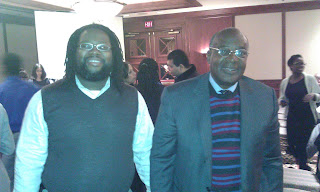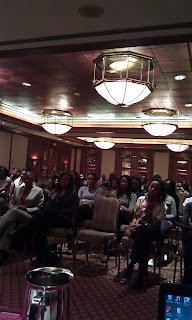In McKinnon v. Ontario (Ministry of Correctional Services) (2001), 39 C.H.R.R. D/308), Professor Hubbard commenced his judgment as follows (in 2001):
Beginning with his human rights complaint of November 29, 1988 (the first of many), the com-plainant, Michael McKinnon, a Canadian of Aboriginal descent, has consistently striven to rid his workplace of the racist behaviour with which, some ten years later, this Board of Inquiry found the Toronto East Detention Centre to have been "redolent ... particularly towards black employees and inmates - which was a matter of considerable concern to the complainant as well, as is made plain by his many documented efforts to have such conduct redressed." What must now be decided is whether his struggles for that particular outcome have thus far been in vain and, if so, what is to be done. (emphasis added)
In McKinnon v. Ontario (Ministry of Correctional Services) 2007 CarswellOnt 9187, Professor Hubbard wrote:
144 Counsel for the Complainant submitted that, since "we are urging you to make factual findings regarding" the Deputy Minister, the Tribunal should order that the Minister has ultimate responsibility for the implementation of its orders. She pointed out that the organizational chart for the Ministry places the Minister at the top (Exhibit 80). In her view, moreover, since the Minister acted as the institutional spokesperson in respect of a call for a public inquiry regarding racial slurs and death threats directed at black officers at various Toronto jails, his ultimate responsibility is clear. The public inquiry was called for by David Mitchell, a deputy superintendent at the TEDC, and Charlene Tardiel, a correctional officer at the Mimico Correctional Complex, who were amongst those who received threatening letters. The Minister's response made reference to the orders of this Tribunal, as indicated in the April 7, 2006 news item in the Toronto Sun (Exhibit 196, Tab 3), which reads in part as follows:
... The request [for an inquiry] comes 15 months after another officer received the first of about 20 letters threatening hundreds of black and South Asian officers working at Toronto jails. ... Certain information in the letters led Mitchell's lawyer, Selwyn Pieters, and [Donald] McLeod [Tardiel's lawyer] to believe they come from colleagues. ... Community Safety and Correctional Services Minister Monte Kwinter said yesterday that police and the ministry are investigating the allegations. He said a public inquiry would have to be called by the attorney general once police finish their investigation. Previous complaints to the Ontario Human Rights Commission led to a tribunal that made recommendations to the ministry, with two outside consultants to ensure the recommendations were implemented, Kwinter said. "There are people who have particular biases," he said. "We have to find out who they are and get them out of there."
Ten years from the 2001 judgment (2011), in what appears to be the continued nonplussed irritation of Professor Hubbard, an adjudicator, with the Human Rights Tribunal of Ontario, of the Ministry of Community Safety and Correctional Services' efforts or the lack thereof to maintain a harassment free and respectful workplace, one that would facilitate Michael McKinnon's return to work, the Tribunal on February 08, 2011 has stated a case of contempt against Deputy Minister [JH] (one of the very few African-Canadians to ever be appointed Deputy Minister in Ontario):
[175] The OED had been established in part to see to the implementation of the board’s orders, and the effectiveness of its work toward that end was of utmost importance to the Complainant. This is reflected in paragraph 40 of his Request, which is as follows:
The Operational Review – Exhibit 40 contains shocking and extremely troubling allegations and findings that were highly relevant to the Tribunal proceedings. Its findings of the state of fear and confusion in the OED raise highly relevant concerns about the OED’s ability to implement orders and address racism. The troubled state of the OED directly affected Mr. McKinnon and Ms. Shaw McKinnon as the staff were not able to implement the Tribunal orders, causing a setback to their implementation for many months, if not indefinitely.
[176] Mr. [JH] knew that there were serious problems in the OED even before Dr. Agard was entrusted to give an accounting of the Ministry’s successes and of its good faith endeavours to comply with the board’s orders. Yet this task was placed in Dr. Agard’s hands even while anonymous emails were circulating about racism, cronyism and unacceptable behaviour within the OED itself. During the course of the hearing, the accusations, feelings and beliefs of staff members described in Exhibit 40 were being gathered and unsavoury rumours of misconduct were swirling around the OED and its embattled Assistant Deputy Minister. Dr. Agard was not fired immediately, but he was effectively replaced in many essential functions by a triumvirate of former police officers in a de facto “reorganization” of the OED of which the parties were not advised and had no means to be aware of. Although Exhibit 40 was not disclosed until Mr. [JH] took the stand, matters had reached the point when on October 1 (four days before he was fired) it was thought advisable to make an oblique and non-judgmental reference to the situation in the OED in order to disclose that change in Dr. Agard’s authority. .....
[182] One last point I would make regarding the exercise of discretion is a reference to Mr. [JH]’s memorandum of September 15, 2010 addressed to “All Correctional Services Division Staff”. In the course of that memorandum, Mr. [JH] makes this statement:
Further to my memos of October 2009 and March 2010, where I spoke of the progress we were making on the implementation of these orders and my intention to be in full compliance by July 2010, I am very pleased to announce that following several months of diligent and concerted effort, we have collectively met that goal. The Ministry is now taking the position that we are in compliance with the HRTO orders but for those contingent on the employee’s return to work.
[183] This memorandum was sent out without any vetting by METRAC, the monitor appointed for the purpose. It was circulated while hearings to determine extremely serious allegations were going on and while a motion to state a case of contempt against the Ministry and Mr. [JH] was pending. Faced with the allegation that this memorandum, too, was shameful, the Ministry’s reply was, in effect, “Well, we simply said that such was the position we are taking, and surely we’re entitled to say that that was how it looked to us.”
[184] One must pause to consider the actual harm and distress that memorandum caused the McKinnons—consequences that I think any reasonable person would have foreseen. The Correctional Services Staff would not say to themselves: “This is simply the Ministry’s position and it may well be that some monitor (of whose existence they are probably ignorant) might disagree and that perhaps more is needed to be done before the long-suffering McKinnons can return safely to work”. Rather, they would most assuredly think, “What’s wrong with the McKinnons. Everything they asked for has been done. All that remains is for them to return. What are they, a couple of freeloaders?” That memorandum seems calculated (“apt”) to show Mr. McKinnon in a bad light and exacerbate his situation, not improve it.
[185] Mr. JH’s memorandum is to be contrasted with Dr. Agard’s admissions made under cross examination that he had mislead the board about the successes allegedly achieved, and in the course of which the following exchange with Ms. Hughes occurred (transcript, page 3398):
Q. ... you said in September, it's safe for Michael McKinnon to return to work.
A. I believe, I believe it was at that time. And when I do provide my thinking, I think all of this will become clear.
Q. But you don't think it's safe for him to return now. You couldn't even survive there, right?
A. No, I couldn't -- I, I – my current opinion?
Q. Yes.
A. Is that what you're asking?
Q. Yes.
A. In my professional opinion, I would say no, it's not safe.
CONCLUSION
[186] Having concluded that the Complainant has established a prima facie case of conduct falling within s.13(1) of the SPPA, for the reasons set out in the last section, I have decided to exercise my discretion in the matter by requesting the Divisional Court to inquire into whether Deputy Minister [JH] is in contempt of the board’s orders.
The penultimate paragraph on which the stated contempt is based does not seem dispositive of the rationale of Professor Hubbard as to why the Deputy Minister Divisional Court should inquire into a stated case of contempt against the Deputy Minister. The Tribunal did not make findings of facts on the credibility of Ralph Agard. It is assumd that he is found to be credible. Problematic and troubling, however, is his admission that he previously misled the Tribunal in his capacity as an Assistant Deputy Minister (ADM). I think one should parce that admission to determine whether it is self-interested, given the former ADM was fired and is in litigation with the Deputy Minister in respect to that termination, particularly over his substantial loss of income, the expenses related to pursuing his lawsuit and any emotional distress, humiliation, loss of respect and esteem, adverse effects upon his personal, social and business life, that resulted from the lost of his job. I guess, from that perspective, upon reflection, I can see how the former ADM would relate to Mr. McKinnon and that is reflected in his answers as cited in para. 185.
Racism, racial profiling, racial harassment and racial stereotyping of Blacks, visible minorities and Aboriginals are not uncommon correctional facilities. And it effect is it creates, entrenches and perpetuates a myth of normality. For the recipient, the result is hurtful and counterproductive. The workplace is also affected, because the public policy in Ontario which “recognize the dignity and worth of every person and to provide for equal rights and opportunities without discrimination that is contrary to law, and having as its aim the creation of a climate of understanding and mutual respect for the dignity and worth of each person so that each person feels a part of the community and is able to contribute fully to the development and well being of the community and province”, is replaced by false negative racial stereotypes, and misinforming perceptions by law enforcement “peace officers” who are sworn to uphold the law.
Mr. McKinnon has the right to a safe and respectful workplace, as all other employees does. Inmates have the right to a safe, harassment free and respectful correctional facility. The issues that arise in the Ministry twarts that. In any event, McKinnon v. Ontario (Correctional Services), 2011 HRTO 263 (CanLII) is very rare, ground-breaking and will certainly garner a lot of attention and litigation.


